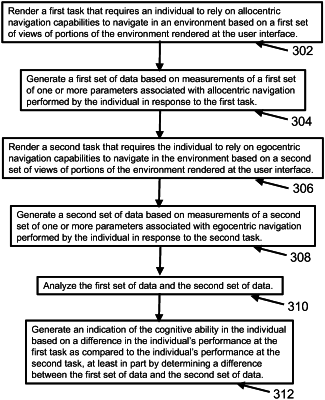| CPC A61B 5/4088 (2013.01) [A61B 5/168 (2013.01); A61B 5/4064 (2013.01); A61B 5/742 (2013.01); A61B 5/7475 (2013.01); G16H 20/70 (2018.01); G16H 50/20 (2018.01)] | 20 Claims |

|
1. An apparatus for generating an assessment of one or more cognitive skills in an individual, said apparatus comprising:
a user interface comprising a display and at least one input device;
a memory to store processor-executable instructions; and
one or more processing units communicatively coupled to the user interface and the memory, wherein upon execution of the processor-executable instructions by the one or more processing units, the one or more processing units are configured to:
render a first task at the user interface, wherein the first task requires an individual to rely on allocentric navigation capabilities to navigate in a virtual environment based on a first set of views of portions of the virtual environment rendered at the user interface,
wherein the first task comprises a first navigation task comprising presenting an elevated view of a virtual landscape that includes an internal course and obstacles and requiring the individual to control a guidable element via the at least one input device from an initial point on the internal course to a target point on the internal course and avoid the obstacles;
generate a first set of data based on measurements of a first set of one or more parameters associated with allocentric navigation performed by the individual in response to the first task;
render a second task at the user interface, wherein the second task requires the individual to rely on egocentric navigation capabilities to navigate in the virtual environment based on a second set of views of portions of the virtual environment rendered at the user interface,
wherein the second task comprises a second navigation task comprising presenting a localized view of the virtual landscape that includes the internal course and the obstacles and requiring the individual to control the guidable element via the at least one input device from the initial point on the internal course to the target point on the internal course and avoid the obstacles without benefit of an aerial view of the entire course or a specified portion of the course;
generate a second set of data based on measurements of a second set of one or more parameters associated with egocentric navigation performed by the individual in response to the second task;
analyze the first set of data and the second set of data to generate an output of a quantitative metric of the individual's performance at the first task and the second task,
wherein the quantitative metric comprises a measure of a degree of optimization of a path navigated by the individual through the internal course;
compare the first set of data and the second set of data to a plurality of performance data for a plurality of individuals in a known disease population, wherein the plurality of performance data comprises performance data for the first task and the second task for the plurality of individuals in the known disease population; and
generate an indication of cognitive ability in the individual based on the quantitative metric and the comparison of the first set of data and the second set of data to the plurality of performance data for the plurality of individuals in the known disease population.
|